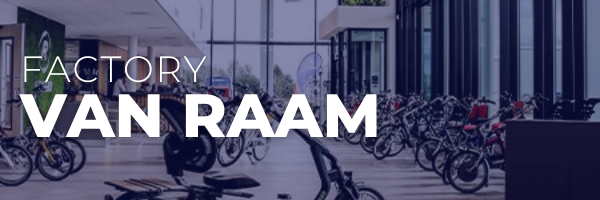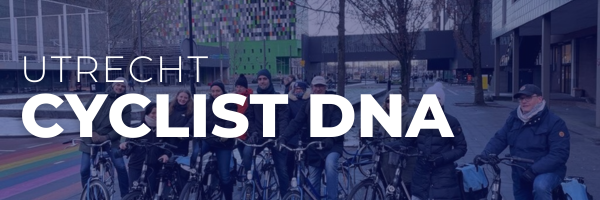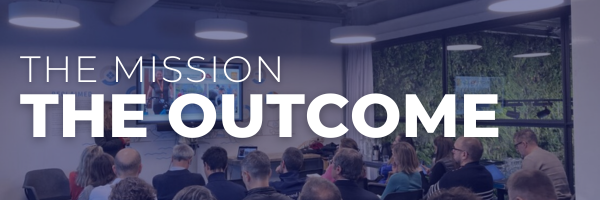Cycling mission in the Netherlands: taking inspiration to the next level
February 12, 2024
Active Mobility Mission, the new challenges of cycling
Heading for the Netherlands
From January 15 to 17, NextMove organized an unprecedented exploratory mission to the Netherlands to discover the cycling ecosystem, in collaboration with the CARA and ID4MOBILITY/CYGO competitiveness clusters and the Dutch Cycling Embassy, a local partner whose aim is to raise the profile of cycling initiatives in Holland. The aim? Through exchanges with experts, hands-on experience and site visits, to understand how bicycle use has exploded in the country, bringing with it an entire industry.

It is snowing on Monday January 15th in the small town of Varsseveld, but not to discourage the managers of Van Raam, a manufacturer of adapted bicycles, who welcomed the eighty-five French participants in the "Mobilité active " mission at the station and invited them to use the bikes to get to the company, some fifteen minutes away. And here we already understand one of the keys to developing bicycle use in the country: infrastructure. It is designed to be regular, very safe, visible and comfortable for the cyclists who use it, even in poor weather conditions.
Infrastructure and, more broadly, development, are the key levers for encouraging people to use bicycles on their daily journeys. First and foremost, of course, are cycle paths, which are organized as a network rather than as individual sections. The city of Delft is a good example: in order to best organize its public space to encourage cycling, Delft consulted all households to find out about their travel habits, and then set up a three-level network (hyper-local, medium, peripheral) which has proved a great success, enabling any type of journey to be made safely by bike.
These trails are designed to be as safe as possible: forgiving infrastructures, no obstacles such as bumps on the trail, sufficient width for several people to pedal... etc.
But thinking about infrastructure also means thinking about the services to be offered to cyclists. In the Netherlands, parking is king. King and queenly: we need to offer almost luxurious parking facilities (we're even talking about monumental parking lots) to attract as many people as possible and encourage them to cycle. This is particularly true in business districts frequented by well-to-do socio-professional categories: the parking lot must have a certain standing so as not to give them the impression of being downgraded by using their bike.
Often managed by Nederlandse Spoorwegen, the national railway company, the parking lot is designed to be very economical, easy to use, clean and pleasant, practical because it's located in the station and connected (to the city, the station and transport applications, including the NS one). It's a key place to encourage intermodality with the train (today, 53% of train users arrive at the station by bike, compared with 26% in 2000), but also to offer repair and maintenance services, thanks to workshops open 24 hours a day in major cities. The result is facilities of considerable importance: in 2019, the city of Utrecht inaugurated the world's largest bicycle parking facility, with a capacity of almost thirteen thousand spaces, which the delegation had the opportunity to visit.
Providing these infrastructures is a necessity today, given the massive use of bicycles in the country, but it was and still is a way of encouraging this use. For a long time, Dutch cities were adapted solely to road traffic, as Emma Stubbe of the Dutch Cycling Embassy explained to members of the French Mobility Clusters. The changeover began in the 1970s, in response to two major challenges: the high number of children dying by bicycle, and the oil crisis, which made the use of personal vehicles more expensive. The development of cycling has not been linear, and Emma highlighted several crucial points, including the importance of experimentation to test new solutions from a test-and-learn perspective, to ultimately encourage cycling.

The delegation was able to experience this first-hand with a visit to the facilities of the city of Utrecht, a leader in bicycle use. The concept of "compact city " (a concept close to the quarter-hour city) is the watchword, giving priority to public transport, pedestrians and above all bicycles, as public spaces are considered to be made for "humans" and not for traffic. Personal vehicles are not banished from the city, but their use is restricted to necessity (by making them less attractive, for example, by extending journey times through detours, or by avoiding on-street parking). Innovative solutions to encourage bicycle use are also being tested, such as ground sensors before traffic lights so that the light turns green when the bicycle arrives at the intersection (pilot project in 2023 and 2024).
The result is that Holland is now the only European country where obesity is falling, and the Dutch are the most active people in the world, preventing an estimated six and a half thousand premature deaths a year due to a sedentary lifestyle. Economically, a whole sector has been structured around cycling, industry, services and the circular economy.
This is the case, for example, of the company Van Raam, manufacturer of adapted bicycles, visited by the delegation, which produces over fifteen thousand bicycles a year, all personalized, to enable people unable to ride an ordinary two-wheeled bicycle to regain their independence and freedom through mobility, or the famous Gazelle velos, which produces a bicycle every eighty-five seconds in its Dieren factory, and which opened its doors to the mission participants. Finally, the delegation visited Roetz, a success story in terms of the circular economy for bicycles: the company works on reconditioning private and shared bikes (around six thousand in total per year), but is also developing its own electrically-assisted bike, which is very easy to recondition or recycle.
Beyond all these initiatives to develop cycling, is there a secret sauce that would explain the Netherlands' success in increasing the modal share of cycling in this way? Spoiler: no. There's no real secret, according to the experts met by the delegation, but a realization on the part of the Dutch: the cost of cycling can save a lot of money, so much more than the use of a private vehicle, that it is the first argument that convinces people to get into the saddle. This is a key factor in the success of cycling in the Netherlands.

It was an enriching mission in terms of discovering best practices, inspiration and ideas, but also in terms of contacts, which would not have been possible without NextMove's partners: the Dutch Cycling Embassy, the companies that hosted the delegation and, of course, the participants. Once again, a big thank you to them for their welcome and their trust!